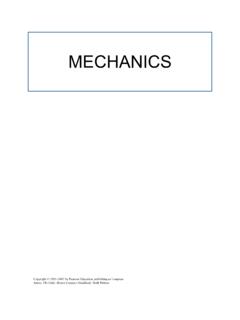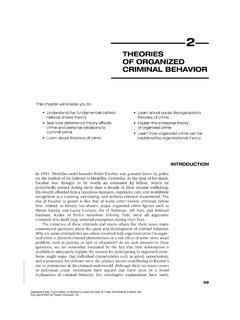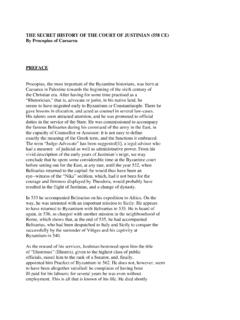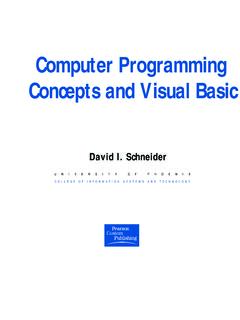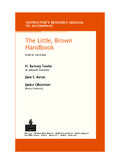Transcription of CHAPTER 43 Gerunds, Infinitives, and Participles - Pearson
1 1/27/06 6:44 PM Page 514. 43a GERUNDS, INFINITIVES, AND Participles . CHAPTER 43. Gerunds, Infinitives, and Participles Participles are verb forms (see 8b). A verb's -ing form is its PRESENT. PARTICIPLE. The -ed form of a regular verb is its PAST PARTICIPLE; IRREGULAR. VERBS form their past Participles in various ways (for example, bend, bent; eat, eaten; think, thought for a complete list, see Box 8-4 in section 8d). Participles can function as ADJECTIVES (a smiling face, a closed book). A verb's -ing form can also function as a NOUN (Sneezing spreads colds), which is called a gerund . Another verb form, the infinitive , can also func- tion as a noun. An infinitive is a verb's SIMPLE or base FORM, usually preceded by the word to (We want everyone to smile).
2 Verb forms Participles , gerunds, and infinitives functioning as nouns or MODIFIERS are called VERBALS, as explained in section 7d. This CHAPTER can help you make the right choices among verbals. Section 43a discusses gerunds and infinitives used as subjects. Section 43b dis- cusses verbs that are followed by gerunds, not infinitives. Section 43c discusses verbs that are followed by infinitives, not gerunds. Section 43d discusses meaning changes that depend on whether certain verbs are followed by a gerund or by an infinitive . Section 43e explains that meaning does not change for certain sense verbs no matter whether they are followed by a gerund or an infinitive . Section 43f discusses differences in meaning between the present participle form and the past participle form of some modifiers.
3 43a How can I use gerunds and infinitives as subjects? Gerunds are used more commonly than infinitives as subjects. Sometimes, however, either is acceptable. Choosing the right health club is important. To choose the right health club is important. A L E R T: When a gerund or an infinitive is used alone as a subject, it is SINGULAR and requires a singular verb. When two or more gerunds or infini- tives create a COMPOUND SUBJECT, they require a plural verb. (See 7k and 10d.). 514. 1/27/06 6:44 PM Page 515. When do I use a gerund , not an infinitive , as an object? 43b 43b When do I use a gerund , not an infinitive , as an object? Some VERBS must be followed by GERUNDS used as DIRECT OBJECTS.
4 Other verbs must be followed by INFINITIVES. Still other verbs can be followed by either a gerund or an infinitive . See Box 43-1: Yuri considered calling [not to call] the mayor. He was having trouble getting [not to get] a work permit. Yuri's boss recommended taking [not to take] an interpreter to the permit agency. gerund after go The word go is usually followed by an infinitive : We can go to see [not go see- ing] a movie tonight. Sometimes, however, go is followed by a gerund in B OX 4 3 - 1 S U M M A RY. Verbs and expressions that must be followed by gerunds acknowledge detest mind admit discuss object to advise dislike postpone anticipate dream about practice appreciate enjoy put off avoid escape quit cannot bear evade recall cannot help favor recommend cannot resist finish regret complain about give up resent consider have trouble resist consist of imagine risk contemplate include suggest defer from insist on talk about delay keep (on) tolerate deny mention understand 515.
5 1/27/06 6:44 PM Page 516. 43c GERUNDS, INFINITIVES, AND Participles . phrases such as go swimming, go fishing, go shopping, and go driving: I will go shopping [not go to shop] after work. gerund after be + complement + preposition Many common expressions use a form of the verb be plus a COMPLEMENT. plus a PREPOSITION. In such expressions, use a gerund , not an infinitive , after the preposition. Here is a list of some of the most frequently used expres- sions in this pattern. SELECTED EXPRESSIONS USING BE + COMPLEMENT + PREPOSITION. be (get) accustomed to be interested in be angry about be prepared for be bored with be responsible for be capable of be tired of be committed to be (get) used to be excited about be worried about We are excited about voting [not to vote] in the next presidential election.
6 Who will be responsible for locating [not to locate] our polling place? A L E R T: Always use a gerund , not an infinitive , as the object of a preposition. Be especially careful when the word to is functioning as a prepo- sition in a PHRASAL VERB (see 42c): We are committed to changing [not to change] the rules. 43c When do I use an infinitive , not a gerund , as an object? Box 43-2 on the next page lists selected common verbs and expressions that must be followed by INFINITIVES, not GERUNDS, as OBJECTS. She wanted to go [not wanted going] to the lecture. Only three people decided to question [not decided questioning] the speaker. infinitive after be + complement Gerunds are common in constructions that use a form of the verb be plus a COMPLEMENT and a PREPOSITION (see 43b).
7 However, use an infinitive , not a gerund , when be plus a complement is not followed by a preposition. We are eager to go [not going] camping. I am ready to sleep [not sleeping] in a tent. 516. 1/27/06 6:44 PM Page 517. When do I use an infinitive , not a gerund , as an object? 43c B OX 4 3 - 2 S U M M A RY. Verbs and expressions that must be followed by infinitives afford to consent to intend to promise to agree to decide to know how to refuse to aim to decline to learn to require to appear to demand to like to seem to arrange to deserve to manage to struggle to ask to do not care to mean to tend to attempt to expect to need to threaten to be left to fail to offer to volunteer to beg to force to plan to vote to cannot afford to give permission to prefer to wait to care to hesitate to prepare to want to claim to hope to pretend to would like to infinitive to indicate purpose Use an infinitive in expressions that indicate purpose: I read a book to learn more about Mayan culture.
8 This sentence means I read a book for the pur- pose of learning more about Mayan culture. To learn delivers the idea of purpose more concisely (see CHAPTER 16) than expressions such as so that I. can or in order to. infinitive with the first, the last, the one Use an infinitive after the expressions the first, the last, and the one: Nina is the first to arrive [not arriving] and the last to leave [not leaving] every day. She's always the one to do the most. Unmarked infinitives Infinitives used without the word to are called unmarked infinitives, or sometimes bare infinitives. An unmarked infinitive may be hard to recognize because it is not preceded by to. Some common verbs followed by unmarked 517.
9 1/27/06 6:44 PM Page 518. 43d GERUNDS, INFINITIVES, AND Participles . infinitives are feel, have, hear, let, listen to, look at, make (meaning com- pel ), notice, see, and watch. Please let me take [not to take] you to lunch. [unmarked infinitive ]. I want to take you to lunch. [marked infinitive ]. The verb help can be followed by a marked or an unmarked infinitive . Either is correct: Help me put [or to put] this box in the car. A L E R T: Be careful to use parallel structure (see CHAPTER 18). correctly when you use two or more gerunds or infinitives after verbs. If two or more verbal objects follow one verb, put the verbals into the same form. NO We went sailing and to scuba dive.
10 YES We went sailing and scuba diving. Conversely, if you are using verbal objects with COMPOUND PREDICATES, be sure to use the kind of verbal that each verb requires. NO We enjoyed scuba diving but do not plan sailing again. [Enjoyed requires a gerund object, and plan requires an infini- tive object; see Boxes 43-1 and 43-2 in this CHAPTER .]. YES We enjoyed scuba diving but do not plan to sail again. 43d How does meaning change when certain verbs are followed by a gerund or an infinitive ? With stop The VERB stop followed by a gerund means finish, quit. Stop followed by an infinitive means interrupt one activity to begin another.. We stopped eating. [We finished our meal.]. We stopped to eat.
